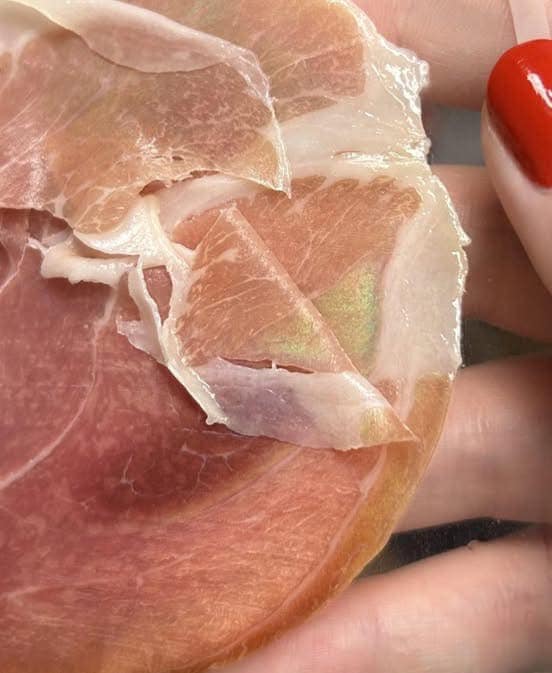ADVERTISEMENT
What Causes the Rainbow Sheen?
The rainbow sheen typically occurs when light hits the surface of the ham at certain angles and is refracted, much like how light can create a rainbow on the surface of a bubble or oily puddle. The specific reasons behind this rainbow effect in ham include:
- Moisture and Natural Proteins: Ham, like other meats, contains a lot of natural proteins, fats, and moisture. The presence of moisture on the surface of the ham, combined with proteins like myoglobin and fatty acids, can create a film on the surface of the meat. When light hits this film, it refracts and reflects, creating the rainbow-like effect.
- Curing Process: During the curing process, especially with smoked or wet-cured hams, salts and other preservatives interact with the meat’s proteins. This can lead to a slight change in the meat’s appearance, particularly when combined with moisture or condensation. The result is often a subtle sheen that may catch the light in a way that creates iridescence.
- Surface Glaze or Coating: Some hams, particularly those that are glazed or have a sugary coating (like honey or brown sugar), can develop a thin layer on their surface. This can also contribute to the rainbow effect, especially when the glaze has a glossy finish that interacts with light. This phenomenon is commonly seen with Christmas hams or holiday hams that are coated in a sugary glaze and then caramelized during cooking.
- Cooking Method: If you’ve recently cooked the ham, the heat could have caused the moisture on the surface to create a subtle film. This film reflects light and produces the rainbow sheen. If you’ve been glazing the ham during cooking, the sugars from the glaze can further enhance this effect.
Is the Rainbow Sheen Safe?
The good news is that rainbow sheen on ham is typically not a sign of spoilage or contamination. It is a natural and harmless occurrence due to the way light interacts with the meat’s surface.
However, there are a few things to keep in mind:
- Check the Smell: While the rainbow sheen is generally harmless, always trust your senses. If the ham has a foul or sour odor, this could indicate that it has gone bad. Fresh ham should have a clean, pleasant smell, and any signs of rancidity or unusual odors should be a red flag.
- Visual Inspection: Along with the rainbow sheen, if you notice other unusual colors, such as green or grayish tints, or if the texture of the ham is off (slimy, overly dry, or sticky), it may be a sign that the meat is not fresh and should be discarded.
- Check the Expiration Date: Make sure that the ham hasn’t passed its expiration date or use-by date. If it’s within the recommended timeframe and properly stored, it should be safe to eat.
Why Does This Happen More Often with Certain Types of Ham?
Some hams are more likely to display the rainbow sheen than others, depending on factors like the cut, preparation, and storage methods:
- Wet-Cured and Smoked Hams: These types of hams are more likely to show a rainbow sheen because they often retain more moisture on the surface. The moisture, along with the curing process, creates the perfect environment for this optical effect to occur.
- Pre-Cooked and Spiral-Cut Hams: Pre-cooked hams, especially those that have been sliced or spiral-cut, are sometimes coated with a glaze or have higher moisture content, making them more prone to displaying this rainbow sheen.
- Holiday Hams with Glazes: Hams that are cooked with sweet glazes, such as honey, maple, or brown sugar, are also more likely to have a glossy finish that can cause the light refracting effect. These hams often look beautiful and shiny, but the sheen is just part of the presentation.
How to Avoid the Rainbow Sheen?
If you prefer to avoid the rainbow sheen and want a more uniform look for your ham, here are a few tips:
- Dry the Surface: Before cooking or glazing your ham, make sure to dry the surface thoroughly with paper towels. This can help reduce the amount of moisture that could contribute to the sheen.
- Use Lower-Moisture Hams: Opt for dry-cured hams (like prosciutto or country ham) or pre-cooked hams that have less moisture on the surface. These types of hams are less likely to form a rainbow sheen during the cooking process.
- Cook at Lower Temperatures: If you are glazing the ham, consider cooking it at a lower temperature to reduce moisture evaporation and prevent the glaze from becoming too wet or reflective.
Conclusion
In most cases, the rainbow sheen on your ham is completely harmless and merely a result of the way light interacts with the meat’s surface. Whether it’s due to moisture, the curing process, or the glaze on your holiday ham, this iridescent effect does not indicate spoilage or contamination. As long as your ham smells fresh, looks normal (aside from the sheen), and is within its expiration date, you can enjoy it without worry.
So, the next time you see a rainbow sheen on your ham, don’t panic! It’s simply a natural phenomenon that many chefs and home cooks encounter regularly. Now that you know what causes it, you can enjoy your meal with peace of mind, knowing that your ham is safe and delicious.
ADVERTISEMENT
ADVERTISEMENT
